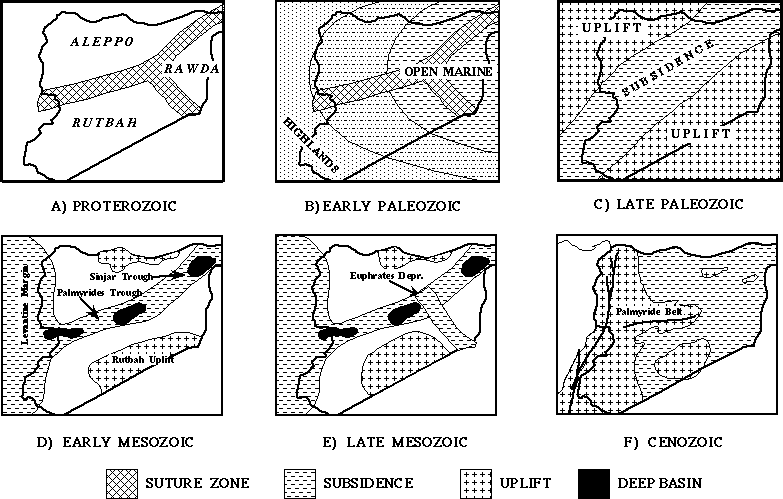Home |
Publications
Best, J. A., Barazangi, M., Al-Saad, D., Sawaf, T. and Gebran,
A.
Continental margin evolution of the northern Arabian platform in Syria
Am. Assoc. Petr. Geol. Bull., 77, 173-193, 1993
Abstract
Synthesis of available geological and geophysical
data in the Syrian Arab Republic permits a descriptive account of the pre-Cenozoic
geologic history of the northern Arabian platform. The northern Arabian platform
appears to be a composite plate similar to that interpreted in the rocks of the
Arabian shield. The structural and stratigraphic relationships of the Paleozoic
and Mesozoic sedimentary sections in Syria record the transformation of an east-facing
Gondwanaland passive-margin in the early Paleozoic into a west-facing Levantine
margin in the Mesozoic, at which time the northern platform was intimately associated
with the creation of the eastern Mediterranean basin. Timing of the margin transformation
is inferred from the orientation and thickness variations of Lower Triassic rocks,
but the transformation may have initiated as early as the Permian. The diversity
and timing of geologic features in Syria suggest that the northern Arabian platform
did not behave as a rigid plate throughout its geologic history. The present-day
Palmyride mountain belt located within the northern Arabian platform in Syria,
initiated in early Mesozoic time as a northeast trending rift nearly perpendicular
to the Levantine margin, was subsequently inverted in the Cenozoic by transpression.
The location of the rift may be associated with the reactivation of a zone of
crustal weakness, i.e., a Proterozoic suture zone previously proposed from modeling
of Bouguer gravity data. Thus, the northern and southern portions of the Arabian
platform have similarities in their geologic history during the Proterozoic and
Paleozoic; however, the northern Arabian platform was intimately affected by Mesozoic
rifting and the creation of the eastern Mediterranean basin during the Mesozoic.
Copyright Statement
Copyright AAPG 1993, reprinted by permission
of the AAPG whose permission is required for further use.
Key Figures and Captions
Figure 13. Diagrammatic tectonic evolution of the northern
Arabian platform in Syria. a) Proposed suturing of at least three distinct crustal
blocks in the Proterozoic, followed by minor Early Cambrian extension; b) Early
Paleozoic epicontinental region of the east-facing Gondwanaland margin; c) development
of Late Paleozoic depocenter in central Syria, as possible precursor to later
Mesozoic rifting; d) Early Mesozoic development of the Levantine margin and
the Palmyride rift; e) second phase of extension in the Late Mesozoic marked
by the development of the Euphrates depression; f) Cenozoic transpressive uplift
of the Palmyride intracontinental mountain belt in central Syria and regional
subsidence in northeast Syria.

Home
| Publications

